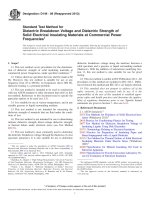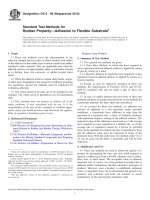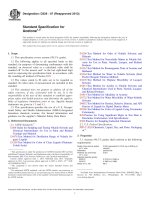Astm d 565 99 (2013)
Bạn đang xem bản rút gọn của tài liệu. Xem và tải ngay bản đầy đủ của tài liệu tại đây (124.77 KB, 3 trang )
Designation: D565 − 99 (Reapproved 2013)
Standard Test Method for
Carbonizable Substances in White Mineral Oil1
This standard is issued under the fixed designation D565; the number immediately following the designation indicates the year of
original adoption or, in the case of revision, the year of last revision. A number in parentheses indicates the year of last reapproval. A
superscript epsilon (´) indicates an editorial change since the last revision or reapproval.
This standard has been approved for use by agencies of the U.S. Department of Defense.
2.3 Government Document:4
21CFR 172.878 Food and Drug Administration Title
1. Scope
1.1 This test method covers white mineral oil (Mineral Oil
USP and Light Mineral Oil NF) to determine whether it
conforms to the standard of quality required for pharmaceutical
use as defined by the United States Pharmacopeia and the
National Formulary, or the Food and Drug Administration.
3. Summary of Test Method
3.1 The mineral oil is treated with concentrated sulfuric acid
(H2SO4) under prescribed conditions and the resulting color is
compared with a reference standard to determine whether it
passes or fails the test.
1.2 The values stated in SI units are to be regarded as
standard. No other units of measurement are included in this
standard.
1.2.1 Exception—Dimension requirements for the color
comparator in Fig. 1 are in SI and inch-pound units.
1.3 This standard does not purport to address all of the
safety concerns, if any, associated with its use. It is the
responsibility of the user of this standard to establish appropriate safety and health practices and determine the applicability of regulatory limitations prior to use. For specific hazard
statements, see Section 6.
4. Significance and Use
4.1 This test method is a means for ascertaining whether
pharmaceutical mineral oil conforms to the standards of the
United States Pharmacopeia, the National Formulary, and the
Food and Drug Administration.
5. Apparatus
5.1 Test Tube, as shown in Fig. 1, of heat-resistant glass
fitted with a well-ground glass stopper, the stopper and the tube
bearing identical and indestructible numbers. The tube shall be
140 6 2 mm in length and between 14.5 and 15.0 mm in
outside diameter, and shall be calibrated at the 5 6 0.2 mL and
10 6 0.2 mL liquid levels. The capacity of the tube with
stopper inserted shall be between 13.6 and 15.6 mL. A rolled
edge can be provided for suspending the tube on the cover of
the water bath.
2. Referenced Documents
2.1 ASTM Standards:2
D1193 Specification for Reagent Water
2.2 Offıcial Compendia:3
United States Pharmacopeia—Current Edition
Monograph on Mineral Oil
National Formulary—Current Edition
Monograph on Light Mineral Oil
5.2 Water Bath, suitable for immersing the test tube above
the 10 mL line equipped to maintain a temperature of 100 6
0.5°C. The bath shall be provided with a cover of any suitable
material with holes approximately 16 mm in diameter through
which the test tubes can be suspended.
1
This test method is under the jurisdiction of ASTM Committee D02 on
Petroleum Products, Liquid Fuels, and Lubricantsand is the direct responsibility of
Subcommittee D02.06 on Analysis of Lubricants.
Current edition approved Oct. 1, 2013. Published October 2013. Originally
approved in 1940. Last previous edition approved in 2009 as D565 – 99 (2009)ε1.
DOI: 10.1520/D0565-99R13.
2
For referenced ASTM standards, visit the ASTM website, www.astm.org, or
contact ASTM Customer Service at For Annual Book of ASTM
Standards volume information, refer to the standard’s Document Summary page on
the ASTM website.
3
Available from U.S. Pharmacopeial Convention, 12601 Twinbrook Parkway,
Rockville, MD 20852.
5.3 Color Comparator, of a suitable type for observing the
color of the acid layer in comparison with the reference
standard color solution. The size and shape of the comparator
are optional, but the size and shape of the apertures shall
conform to the dimensions prescribed in Fig. 1.
4
Available from Standardization Documents Order Desk, DODSSP, Bldg. 4,
Section D, 700 Robbins Ave., Philadelphia, PA 19111-5098.
Copyright © ASTM International, 100 Barr Harbor Drive, PO Box C700, West Conshohocken, PA 19428-2959. United States
1
D565 − 99 (2013)
FIG. 1 Color Comparator for Carbonizable Substances in Liquid Petrolatum
dissolved, titrate the liberated iodine with 0.100 M sodium
thiosulfate (Na2S2O3) solution, using starch solution as an
indicator. Each millilitre of Na2S2O3 solution is equivalent to
0.0238 g of CoCl2·6H2O. Adjust the final volume of CoCl2
solution by the addition of HCl solution so that 1 mL contains
59.5 mg of CoCl2·6H2O.
6. Reagents
6.1 Purity of Reagents—Reagent grade chemicals shall be
used in all tests. Unless otherwise indicated, it is intended that
all reagents shall conform to the specifications of the Committee on Analytical Reagents of the American Chemical Society,
where such specifications are available.5 Other grades may be
used, provided it is first ascertained that the reagent is of
sufficiently high purity to permit its use without lessening the
accuracy of the determination.
NOTE 1—This freshly prepared H2SO4 solution will be hot. Allow to
cool before continuing.
6.4 Cupric Sulfate Solution (0.25 M)—Prepare a solution of
HCl (Warning—see 6.3) by mixing 30 mL of concentrated
HCl with 1170 mL of water. Slowly add the acid to the water.
Dissolve 65 6 1 g of cupric sulfate pentahydrate
(CuSO4·5H2O) in enough HCl solution to make 1000 mL of
solution. Using a pipet, transfer 10 mL of the solution to a
250-mL iodine flask, add 40 mL of water. Prepare a 6M acetic
acid (CH3COOH) (Warning—Corrosive. Combustible. Vapor
irritating.) solution by mixing 353 mL of concentrated
CH3COOH with 1000 mL of water. Slowly add the acid to the
water. Add 4 mL of 6M CH3COOH, 3 g of Kl and 5 mL of HCl
to the flask. Titrate the liberated iodine with 0.100 M Na2S2O3
solution, using starch solution as an indicator. Each millilitre of
Na2S2O3 solution is equivalent to 0.0250 g of CuSO4·5H2O.
Adjust the final volume of the CuSO4 solution by the addition
of diluted HCl solution so that 1 mL contains 62.4 mg
CuSO4·5H2O.
6.2 Purity of Water—Unless otherwise indicated, references
to water shall be understood to mean distilled water or water of
equal purity conforming to Type III of Specification D1193.
6.3 Cobaltous Chloride Solution (0.25 M)—Prepare a solution of hydrochloric acid (HCl) (Warning—Causes burns.
Vapor extremely irritating.) by mixing 30 mL of concentrated
HCl with 1170 mL of water. Slowly add the acid to the water.
Dissolve 65 6 1 g of cobaltous chloride hexahydrate
(CoCl2·6H2O) in the HCl solution to make 1000 mL of
solution. Using a pipet, transfer 5 mL of this solution to a 250
mL iodine flask. Prepare a solution of sodium hydroxide
(NaOH) ( Warning—Corrosive. Can cause severe burns or
blindness. Evolution of heat produces a violent reaction or
eruption upon too rapid a mixture with water.) by mixing 5 g
of NaOH with 20 mL of water. Add 15 mL of this NaOH
solution to the iodine flask. Add 5 mL of hydrogen peroxide
(H2O2) (3 % v/v). Boil for 10 6 1 min, cool, and add 2 g of
potassium iodide (KI). Prepare a solution of H2SO4
(Warning—Causes burns. Vapor extremely irritating. Strong
oxidizer.) by mixing 6 mL of H2SO4 with 18 mL of water.
Slowly add the acid to the water (see Note 1). Add 20 mL of
this H2SO4 solution to the flask.) When the precipitate has
6.5 Ferric Chloride Solution (0.166 M)—Prepare a solution
of HCl (Warning—see 6.3) by mixing 30 mL of concentrated
HCl with 1170 mL of water. Dissolve 55 6 1 g of ferric
chloride hexahydrate (FeCl3·6H2O) in enough HCl to make
1000 mL of solution. Using a pipet, transfer 10 mL of this
solution into a 250-mL iodine flask, add 15 mL water, 3 g KI
and 5 mL HCl, and allow the mixture to stand for 15 6 1 min.
Dilute with 100 mL of water and titrate the liberated iodine
with 0.100 M Na2S2O3 solution, using starch solution as an
indicator. Each millilitre of Na2S2O3 solution is equivalent to
0.0270 g of FeCl3·6H2O. Adjust the final volume of FeCl3
5
Reagent Chemicals, American Chemical Society Specifications, American
Chemical Society, Washington, DC. For Suggestions on the testing of reagents not
listed by the American Chemical Society, see Annual Standards for Laboratory
Chemicals, BDH Ltd., Poole, Dorset, U.K., and the United States Pharmacopeia
and National Formulary, U.S. Pharmacopeial Convention, Inc. (USPC), Rockville,
MD.
2
D565 − 99 (2013)
shakes over an amplitude of about 127 mm, shaking the test
tube quickly and at a rate corresponding to 5 shakes/s. (A
shaking machine may be employed provided the results that
can be obtained agree with those obtained by the prescribed
manual agitation.) Repeat every 30 s. Do not keep the test tube
out of the bath longer than 3 s for each shaking period.
solution by the addition of the HCl solution so that 1 mL
contains 45.0 mg of FeCl3·6H2O.
6.6 The solutions prepared in 6.3 – 6.5 may be prepared in
different quantities, provided the ratios of components are
equivalent.
6.7 Colorimetric Reference Standard Solution—Prepare a
reference standard pale amber solution for color comparison by
mixing together 1.5 parts of CoCl2 solution, 3.0 parts of the
FeCl3 solution, and 0.5 parts of the CuSO4 solution. Measure
5 mL of this mixture into a test tube as specified in 5.1. This
pale amber reference standard shall then be overlaid with 5 mL
of white mineral oil.
7.4 At the end of 10 min from the time the test tube was first
placed in the bath, remove the test tube and allow to stand in
the room for not less than 10 min nor more than 30 min.
Observe and record any discoloration of the oil layer. Place the
test tube in the color comparator, and compare the acid layer
with 5 mL of the standard colorimetric solution and 5 mL of
white mineral oil in a test tube that has been shaken vigorously
for 10 s and allowed to stand just long enough for the contents
to separate into two layers.
6.8 Sulfuric Acid (94.7 6 0.2 %)—The H2SO4 shall be
nitrogen-free when analyzed in accordance with the following
procedure: Dilute a small amount of the acid with an equal
volume of water and superimpose 10 mL of the cooled liquid
upon diphenylamine solution (1 g of diphenylamine in 100 mL
of concentrated H2SO4). A blue color should not appear at the
zone of contact within 1 h. This test detects as little as
0.0002 % nitric acid (HNO3).
8. Interpretation of Results
8.1 White mineral oil shall be reported as passing the test
only when the oil layer shows no change in color (see Note 2)
and when the acid layer is not darker than the reference
standard colorimetric solution.
7. Procedure
NOTE 2—A bluish haze or a slight pink or yellow color in the oil layer
should not be interpreted as a change in color.
7.1 Clean a test tube with a chromic acid (H2 CrO4) cleaning
solution (Warning—Causes severe burns. A recognized carcinogen. Strong oxidizer.), or use a nonchromium containing,
strongly oxidizing cleaning solution.
8.2 If the oil layer is discolored or if the acid layer is darker
than the reference standard colorimetric solution, white mineral oil shall be reported as not passing the test.
9. Precision and Bias
7.2 Fill the test tube to the 5 mL mark with H2SO4 (94.7 6
0.2 %). Then add the oil to be tested to the 10-mL mark, insert
the stopper loosely, and place the test tube in position in the
water bath at 100 6 0.5°C.
9.1 No statement is made about either the precision or bias
of this test method since the result merely states whether there
is conformance to the criteria for success specified in the
procedure.
7.3 After the test tube has been in the water bath for 30 s,
loosen the stopper sufficiently to release any pressure and
reinsert, remove the test tube from the bath quickly, hold with
a finger over the stopper, and give three vigorous, vertical
10. Keywords
10.1 carbonizable substances; mineral oil
ASTM International takes no position respecting the validity of any patent rights asserted in connection with any item mentioned
in this standard. Users of this standard are expressly advised that determination of the validity of any such patent rights, and the risk
of infringement of such rights, are entirely their own responsibility.
This standard is subject to revision at any time by the responsible technical committee and must be reviewed every five years and
if not revised, either reapproved or withdrawn. Your comments are invited either for revision of this standard or for additional standards
and should be addressed to ASTM International Headquarters. Your comments will receive careful consideration at a meeting of the
responsible technical committee, which you may attend. If you feel that your comments have not received a fair hearing you should
make your views known to the ASTM Committee on Standards, at the address shown below.
This standard is copyrighted by ASTM International, 100 Barr Harbor Drive, PO Box C700, West Conshohocken, PA 19428-2959,
United States. Individual reprints (single or multiple copies) of this standard may be obtained by contacting ASTM at the above
address or at 610-832-9585 (phone), 610-832-9555 (fax), or (e-mail); or through the ASTM website
(www.astm.org). Permission rights to photocopy the standard may also be secured from the Copyright Clearance Center, 222
Rosewood Drive, Danvers, MA 01923, Tel: (978) 646-2600; />
3









